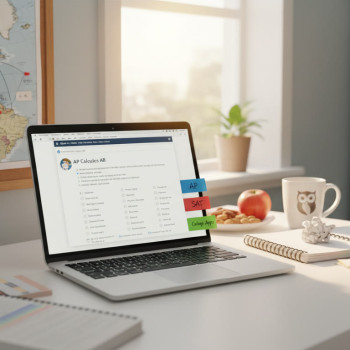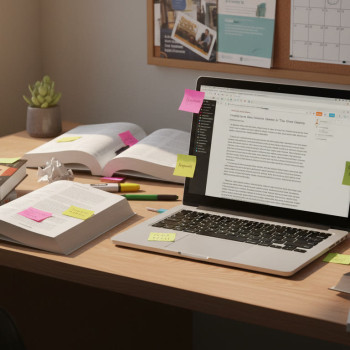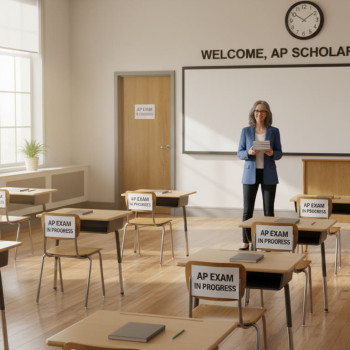Why Your Seating or Desk Setup Matters (and Why You Should Ask)
It’s easy to dismiss the physical details of a test room as background noise — a seat, a table, a clock — but the right desk setup can quietly change everything about how you think, breathe, and perform. For AP exams, where concentration, timing, and clear thinking are everything, a desk that fits your body, a seating arrangement that reduces sensory overload, or a setup that accommodates a physical or medical need isn’t a luxury. It’s part of your testing toolkit.

Real impact, real examples
Consider three quick, real-world scenarios:
- A student with back pain performs markedly better when provided a chair with lumbar support and a slightly larger desk to place materials comfortably.
- A student diagnosed with sensory processing issues avoids distraction when seated away from bright lights and near a quieter wall.
- A student who types essays faster than they write benefits from permission to use a laptop and a larger desk area to accommodate the device and notes.
These are not edge cases — they’re everyday realities for many AP students. The College Board recognizes that students test best when they can access the environment they need. The key is knowing how to request it, document it, and advocate for it early and professionally.
Understand the College Board Accommodation Framework
Before you start typing emails or filling out forms, spend a little time understanding the structure. The College Board’s Services for Students with Disabilities (SSD) is the office that approves accommodations for AP exams. Most schools have an SSD or 504/IEP coordinator who helps students navigate the process and submit requests through the College Board’s SSD online portal.
What kinds of seating or desk accommodations are commonly approved?
Seating and desk requests may fall under a few broad categories:
- Physical/ergonomic modifications: special chairs, back support, adjustable desks.
- Sensory and environmental modifications: seat placement away from doors, windows, or fluorescent lights; low-distraction rooms.
- Equipment accommodations: permission to use a laptop, large desk space for adaptive equipment, or space for assistive devices like magnifiers.
- Separate-room testing: often required when additional time, frequent breaks, or specialized supervision is part of the approved accommodation.
It’s important to know that the College Board evaluates requests based on documented need. That’s why working with your school’s SSD coordinator and providing clear evidence is so important.
Step-by-Step: How to Request Customized Seating or Desk Setup
Timing and clarity are your allies. The process involves your school, documentation, and a bit of planning. Here’s a practical checklist you can follow.
1. Start Early — talk to your school’s SSD or AP coordinator
Don’t wait until the week before exams. Initiate the conversation months in advance so there’s room for documentation, submission, and any needed follow-ups. Most schools have an SSD coordinator who will submit the official request through the College Board portal for you.
2. Collect clear documentation
The College Board usually asks for documentation that shows the functional impact of your condition. This can include:
- An IEP (Individualized Education Program) or 504 Plan.
- A letter from a physician, psychologist, or qualified specialist describing the condition, how it affects test-taking, and recommended accommodations.
- Recent educational evaluations or therapy summaries that support the need for a specific desk or seating arrangement.
Tip: Make those documents specific to testing conditions. For example, a note that states, “Requires adjustable desk height due to chronic back pain to prevent muscle strain during prolonged seated work,” is more actionable than a vague medical summary.
3. Specify the exact setup you need
Be precise. Rather than saying “I need a different desk,” spell out what will work for you. Concrete requests are easier to approve and coordinate:
- “Adjustable-height desk that accommodates a wheelchair and a laptop.”
- “Chair with lumbar support and an extra 12 inches of tabletop on the right side for assistive equipment.”
- “Seat placement away from the door and fluorescent lights; near a wall to reduce visual distractions.”
If you’re unsure what exactly you need, ask your occupational therapist, school nurse, or SSD coordinator for recommendations. They can help translate comfort needs into specific exam-room requests.
4. Submit the request through SSD online (or ask the coordinator to do it)
Your school’s SSD coordinator will submit the request to the College Board. This step is crucial — accommodations must be approved by the College Board in advance. Keep in mind the College Board’s deadlines for accommodation requests and AP exam ordering; missing them can complicate or delay approval.
5. Confirm and follow up
Once your request is submitted, follow up. Ask your SSD coordinator to confirm when the College Board approves the accommodation, and to verify that the AP coordinator has ordered any special materials or room assignments needed for exam day. For digital AP exams, some accommodations must be confirmed in the AP registration system so the right version of the exam is prepared.
What If You Don’t Have an Existing IEP or 504 Plan?
Not every student with a temporary or medical need has formal school accommodations. The College Board allows requests for temporary physical or medical conditions, but you’ll need documentation. If you have a recent injury, surgery, or temporary medical impairment, obtain a note from your healthcare provider that explains the limitation and proposed accommodations for testing.
Best practices for temporary requests
- Attach a clear start and expected end date to the documentation (e.g., “May 15–June 15, 2026”).
- Provide objective details: weight-bearing restrictions, device requirements (e.g., wheelchair), or physical limitations (e.g., inability to sit upright for more than 20 minutes).
- Work with your school’s SSD coordinator to submit a temporary accommodations request through the SSD portal.
Sample Timeline — Plan Backwards From Exam Day
To avoid last-minute stress, here’s a sample timeline that will keep you organized. Adjust based on your school calendar and the College Board’s published deadlines.
| When | What to Do | Why It Matters |
|---|---|---|
| 6 months before exams | Start conversations with your SSD/AP coordinator and request any evaluations. | Gives time to gather documentation and submit requests. |
| 3 months before exams | Submit documentation and have the SSD coordinator file the request online. | Early submission reduces risk of delays. |
| 1–2 months before exams | Confirm College Board decision and coordinate exam-room logistics with the AP coordinator. | Ensures materials and room assignments are in place. |
| Week of the exam | Bring SSD Eligibility Letter (if required) and any assistive gear; confirm where you’ll sit. | Reduces surprises on test day and helps you arrive relaxed. |
What to Expect on Exam Day
When your accommodation is approved, a few practical things will likely happen:
- You may be assigned to a separate room, particularly if you require extended time or extra breaks.
- The room will be set according to the requested setup — e.g., larger desk, specific seat placement, or placement of assistive devices.
- If you use devices like a laptop or magnifier, you’ll usually have to bring them and may need to check them in with proctors for inspection before the exam.
Pro tip: Visit the exam room if possible before test day to get familiar with the seating and lighting. Familiar surroundings reduce anxiety and help you conserve mental energy for the test itself.
Common Questions and Troubleshooting
What if the school says they can’t provide a requested chair or desk?
First, ask for specifics — is it a budgeting issue, availability, or misunderstanding about the requirement? Sometimes simple substitutions (a different chair that still provides lumbar support, or a folding table with extra surface area) are acceptable. If the school cannot meet the need, work with the SSD coordinator to escalate the case; the College Board may offer guidance or require the school to find reasonable alternatives so the accommodation is honored.
What if the College Board denies my request?
It happens. If a request is denied, don’t panic. Ask the SSD coordinator for details and whether additional documentation could change the decision. You can often resubmit with more specific evidence from a clinician or therapist. The important part is to respond quickly and provide the clarifying information requested.
Can I request last-minute changes on exam day?
Generally, no. Accommodations need approval before the exam. If you have an emergency or an unexpected issue on exam day, talk to the SSD coordinator and AP coordinator immediately; they’ll help, but the College Board requires advance approval for most accommodations.
How to Make Your Seating Request Sound Professional and Persuasive
Communication matters. A concise, evidence-based request reduces back-and-forth and increases the chance of approval. Here’s a short template for what you might give to your SSD coordinator or use as a basis for clinician notes:
“Student X has a documented medical/physical need (brief condition) that affects sustained seated work. Clinical evaluation by [Provider Name, Title] on [Date] recommends [specific desk/chair/placement]. This modification is necessary to allow the student to maintain posture, limit pain, and access the exam for the full duration without undue fatigue. The recommended accommodation is [precise request].”
Short, factual, and clinically supported language goes a long way.
Study Smart: Simulate Your Accommodated Test Conditions
Once the accommodation is approved, incorporate it into your practice. If you’ll take the exam in a separate room, try timed practice sessions in a quiet space. If you’ll use a laptop or a particular chair, practice typing essays on that device and sitting in that chair for full-length practice tests.
Why this matters
Testing is as much about muscle memory and rhythm as it is about content knowledge. The quiet click of keys, the feel of the desk, and the cadence of a proctored setting all contribute to test-day comfort. The more your practice environment matches your actual test setup, the fewer surprises you’ll face.
How Tutoring Can Support the Accommodation Process (and Test Performance)
Personalized support helps on two fronts: practical preparedness and advocacy. A skilled 1-on-1 tutor can tailor study plans to your testing conditions (for example, designing practice sessions timed to your approved extra time), help you practice with assistive devices, and coach you on how to communicate needs with school staff. Sparkl’s personalized tutoring offers tailored study plans, expert tutors, and AI-driven insights that can shape practice sessions to mirror your accommodated exam—so you build confidence in the exact environment in which you’ll test.
Checklist: Documents and Items to Bring on Exam Day
- SSD Eligibility Letter or documentation verifying your accommodation approval.
- Any assistive devices you were approved to use (laptop, magnifier, cushion), fully charged and clearly labeled if needed.
- Medical notes or letters only if the proctor requests them — typically the SSD letter is sufficient.
- Comfort items allowed by the proctor (water bottle with a secure lid, etc.).
- Arrive early to locate the test room and confirm the desk/chair arrangement.
Short Case Study: How a Simple Desk Swap Boosted Confidence
Sara, an AP Biology student, had a chronic neck issue that made long sessions at cramped desks painful. Her occupational therapist recommended a chair with a higher back and a larger desk surface. Sara and her SSD coordinator submitted the documentation early. The College Board approved the request, and her AP coordinator arranged a quiet room with the requested desk. The difference was subtle but profound: Sara reported less pain, better focus, and an ability to complete all sections without rushed answers. Her practice sessions, guided by a tutor who modeled timing for her approved extended time, helped her translate comfort into performance.
Final Tips: Be Proactive, Specific, and Persistent
As you prepare for AP exams, keep these final reminders in mind:
- Start early. Documentation, submission, and approval take time.
- Be specific about what you need and why. Vague requests are harder to act on.
- Use practice to build familiarity with your approved setup.
- Keep communication professional and document key steps—emails confirming approvals, copies of submitted forms, and appointment notes.
- Leverage help. An SSD coordinator, clinician, or a personal tutor can help you prepare both the paperwork and the practice plan for the best possible performance on exam day.

Wrap-Up: Your Environment Is Part of Your Strategy
Customized seating and desk setups are not about privilege — they’re about access and fairness. When the environment supports how you work best, your knowledge has room to shine. Advocate early, document clearly, and practice intentionally in the exact conditions you’ll face. And remember, you don’t have to do it all alone: your school’s SSD coordinator, clinicians, and supportive 1-on-1 tutoring—like the personalized plans and expert guidance Sparkl offers—can make the logistics and the learning much smoother.
Ask for what you need, practice how you’ll perform, and walk into the exam room with the calm confidence that comes from being prepared, comfortable, and supported.























No Comments
Leave a comment Cancel